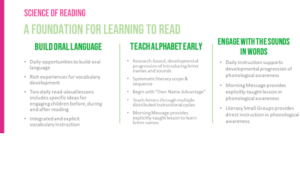April 4, 2023 / Blog
Setting the Foundation of the Science of Reading in Early Childhood
The ability to read is one of the most fundamental skills a child can learn, laying a foundation for school readiness and equipping them with tools to help them make sense of the world around them. Many parents and educators are unaware of the evidence-based methods for teaching reading and instead rely on outdated or ineffective practices that leave some children with learning difficulties behind. In this article, we will explore what the science of reading is, and how Frog Street, a leading early childhood curriculum company, is setting the foundation for this approach.
What Is the Science of Reading?
The science of reading is a multi-disciplinary examination of how people learn to read. It encompasses research from various fields such as linguistics, psychology, and neuroscience to understand the cognitive processes involved in the early stages of learning to read all the way to building vocabulary and comprehension.
Recognizing that the human brain is not naturally wired for reading is a crucial component of the science of reading. Reading is a human invention and not an evolutionary product like spoken language. While educators debated the most effective methods to teach reading during the “reading wars” of the 90s, researchers from different scientific backgrounds were conducting studies examining the brain’s mechanisms for learning to read. From these studies, a consensus emerged answering questions about how the brain acquires reading skills and this is what we refer to when talking about the science of reading.
The Five Components of the Science of Reading
The science of reading is built around five key components, which are critical to the development of reading skills in young children. In this section, we will explore each of these components and their importance in teaching and building strong reading skills.
Phonemic Awareness – The ability to recognize and manipulate individual sounds (phonemes) in words. Children who have developed phonemic awareness can break down words into their component sounds and blend those sounds together to form words. Phonemic awareness is distinct from phonics, which involves understanding the relationship between letters and sounds. Phonemic awareness is a more basic skill that must be developed before children can effectively use phonics to read and write. There are many activities that can help develop phonemic awareness, such as rhyming games, sound segmentation exercises, and phoneme substitution tasks.
Phonics – The relationship between letters and sounds in written language. Phonics instruction begins with teaching the sounds that individual letters make and then progresses to more complex letter combinations and syllables. Children learn to identify and blend sounds, and eventually develop the ability to read and write words on their own. Phonics is a key component of early literacy instruction, and research shows that effective phonics instruction results in improved reading skills for all students, including those with reading difficulties. As Dr. Martin Kozloff, a professor of education and an expert in the science of teaching reading notes, “When a child memorizes ten words, they can only read ten words. If a child learns the sounds of ten letters, they will be able to read: 350 three-sound words, 4,320 four-sound words, and 21,650 five-sound words”.
Fluency – The ability to read quickly and accurately. Reading fluency is developed by combining explicit instruction and practice. Educators and parents can use techniques such as repeated reading, timed reading, and choral reading (reading aloud in pairs or groups) to help children build fluency. Exercises aimed at fluency focus on the development of both automatic word recognition and fluent expression, keeping an understanding of the text as the central goal. Providing children with engaging and developmentally appropriate challenging reading materials has been shown to promote strong fluency development.
Vocabulary – The set of words that a reader knows and understands, and can use to comprehend written text. Strategies to help build the vocabulary of children include explicit instruction on new words, the use of context clues to infer meaning from text, and encouraging the child to read a variety of texts independently so they can encounter new words in context. Although vocabulary development is an important part of early reading instruction, it is an ongoing process that occurs throughout a person’s life. Overall, vocabulary is an important aspect of the science of reading, and effective vocabulary instruction can help children with comprehension and engage with new ideas and concepts, building on skills outside of reading.
Reading Comprehension – Understanding and interpreting the meaning of the written text. Effective reading comprehension instruction includes both explicit teaching of comprehension strategies and ample opportunities for children to practice those strategies with a variety of texts. Reading comprehension development can be taught through modeling the use of comprehension strategies, collaborative discussion around text, and scaffolding support as needed. Research shows that effective reading comprehension instruction is essential for success across all academic subjects. Children who struggle with reading comprehension may benefit from targeted instruction and support, including additional practice with comprehension strategies and explicit instruction in vocabulary and background knowledge.
While reading comprehension is the ultimate goal of reading instruction through the science of reading curriculums, it is not a stopping point. Like vocabulary, reading comprehension skills can be built upon throughout a reader’s lifetime.
By learning these foundational skills, children build a base of knowledge connecting written and spoken language and can become proficient readers who can access and understand a wide range of texts. Understanding the science of reading is essential for educators to effectively teach children how to read and set them up for success in their academic and personal lives.
The science of reading also emphasizes the importance of early intervention for children who struggle with learning to read as well as the ongoing assessment and monitoring of children’s progress in order to empower targeted support and instruction.
Setting the Foundation for the Science of Reading
Research in the science of reading has shown that the most effective reading instruction for young children includes a combination of explicit instructions in phonics, vocabulary, and comprehension, as well as opportunities to read independently and practice skills in meaningful contexts.
Therefore, it is important in early childhood education to provide literacy experiences to form the foundation for learning to read. These experiences should emphasize the key predictors of early literacy: oral language, alphabetic code (letter knowledge, phonological awareness), print knowledge and concepts, comprehension, and written expression. Frog Street’s early childhood curriculum uses this evidence-based research to apply techniques to help children learn the fundamentals of reading, which yields compound results once they can understand language and conceptualize the world around them through the written word.
As you can see by the chart below, Frog Street provides literacy experiences to form the foundation for learning to read by building oral language, teaching the alphabet early and engaging children with the sounds of words.

